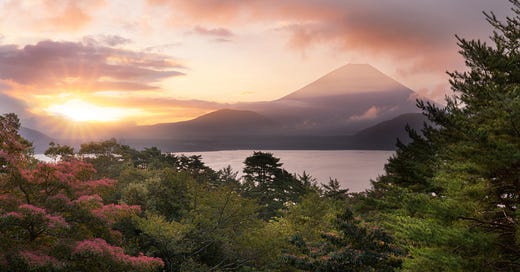Lake Motosu at sunrise with Mt Fuji in the background. Photo by Shutterstock, used with permission.
October in Japan is a month that gracefully straddles the line between tradition and modernity, offering a vivid palette of experiences that reflect the country’s unique cultural rhythms. As the oppressive summer heat fades and the crisp autumn air begins to settle in, Japan transforms into a land of vibrant colors and cultural festivities, making October one of the most enchanting times to explore the country.
The Magic of Koyo
One of the most iconic images of Japan in October is the phenomenon of koyo (紅葉), the changing of the leaves. From the northern reaches of Hokkaido to the ancient temples of Kyoto, the landscape is awash with shades of red, orange, and gold. These autumn hues are not just a visual delight but a deep cultural experience that resonates with the Japanese appreciation of transient beauty, a concept rooted in the philosophy of mono no aware (物の哀れ), the gentle sadness of things.
In places like Kyoto’s Arashiyama or Nikko’s sacred shrines, the autumn leaves are the main attraction. Local festivals often coincide with the peak of the foliage, adding a layer of cultural significance to the natural beauty. In Kyoto, the annual Jidai Matsuri (時代祭), or Festival of the Ages, sees participants dressed in historical costumes parading through streets lined with fiery maples, offering a living tapestry of Japan’s rich history against the backdrop of nature’s artistry.
Culinary Delights
October is also a time when the culinary landscape shifts to reflect the season’s bounty. The concept of shun (旬), eating foods at the peak of their season, is particularly important to celebrate in autumn. October is characterized by the flavors of mushrooms, sweet potatoes, chestnuts, and the highly prized matsutake mushrooms, which are often referred to as the “king of autumn flavors.”
In rural areas, the arrival of the rice harvest is acknowledged by festivals like the Hida Takayama Autumn Festival in Gifu Prefecture, where you can enjoy mochi (rice cakes) freshly pounded in the traditional way, or sample sake made from the first rice of the season. Visiting a local izakaya during this time offers the chance to experience seasonal kaiseki meals, where each dish is crafted to highlight the flavors of autumn ingredients.
Festivals and Celebrations
October is a month rich in cultural festivities, many of which have been celebrated for centuries. In Tokyo, the Oeshiki Festival at Ikegami Honmonji Temple commemorates the death anniversary of Nichiren, the founder of the Nichiren sect of Buddhism. The festival is marked by a massive parade featuring mando (lanterns mounted on tall poles) and taiko drumming, creating a lively and spiritual atmosphere that contrasts with the otherwise bustling city.
Another notable event is the Nagasaki Kunchi Festival, a vibrant celebration with a history stretching back over 400 years. Held from October 7th to 9th, this festival features dragon dances, float parades, and performances that reflect Nagasaki’s unique blend of Japanese and foreign cultures, a legacy of its history as a gateway for trade and cultural exchange.
A Season of Reflection and Renewal
October in Japan is also a time for reflection, as it precedes the more solemn winter months. The cooler weather and the gradual shortening of days bring about a contemplative mood, echoed in the haiku and tanka poetry often composed during this season. For travelers, it’s a perfect time to slow down and immerse oneself in the quieter, more introspective aspects of Japanese culture.
Whether you’re strolling through a momiji garden, savoring the flavors of an autumn feast, or participating in a centuries-old festival, October offers a deeply enriching experience that encapsulates the essence of Japanese culture. It’s a month where the past and present harmoniously coexist, inviting both locals and visitors to appreciate the fleeting beauty of the season and the timeless traditions that continue to thrive in modern Japan.




